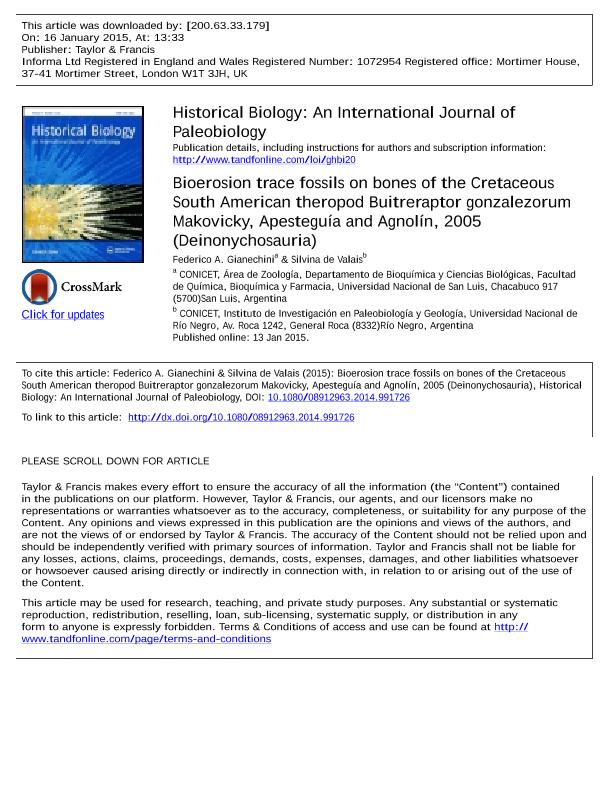Artículo
Bioerosion trace fossils on bones of the Cretaceous South American theropod Buitreraptor gonzalezorum Makovicky, Apesteguía and Agnolín, 2005 (Deinonychosauria)
Fecha de publicación:
01/2015
Editorial:
Taylor & Francis
Revista:
Historical Biology: An International Journal of Paleobiology
ISSN:
0891-2963
Idioma:
Inglés
Tipo de recurso:
Artículo publicado
Clasificación temática:
Resumen
The ichnological record provides valuable information on the lifestyle, behaviour, and other palaeobiological and palaeoecological aspects of the biota. Here, we describe an interesting case of bioerosion trace fossils in bones of Buitreraptor gonzalezorum Makovicky, Apesteguı´a and Agnolı´n, 2005, a deinonychosaurian theropod from the fossiliferous locality of La Buitrera, Rı´o Negro, Patagonia, Argentina. The trace fossils are morphologically diverse and preserved in a great percentage of the skeleton, including the jaw, vertebrae and limbs. Four main groups of trace fossils have been informally named as Parallel-Edge Furrows, Overlapped Grooves, Punctures and Lined. Parallel-Edge Furrows are in turn subdivided into four subgroups: isolated furrows, parallel pairs, opposed pairs and a combination of parallel and opposed pairs. The bioerosion trace fossils were probably generated by scavenging activities, and the semi-articulated preservation of the skeleton and the small size of each individual trace indicate small-sized tracemakers. Mammals are the main candidates although some traces may have been generated by crocodyliforms and insects such as dermestids and termites. This evidence provides additional information about palaeoenvironmental conditions, taphonomic processes, taxonomic diversity and ecological relationships that characterised this part of northern Patagonia at Early Cretaceous times.
Archivos asociados
Licencia
Identificadores
Colecciones
Articulos(CCT - SAN LUIS)
Articulos de CTRO.CIENTIFICO TECNOL.CONICET - SAN LUIS
Articulos de CTRO.CIENTIFICO TECNOL.CONICET - SAN LUIS
Citación
Gianechini, Federico Abel; de Valais, Silvina; Bioerosion trace fossils on bones of the Cretaceous South American theropod Buitreraptor gonzalezorum Makovicky, Apesteguía and Agnolín, 2005 (Deinonychosauria); Taylor & Francis; Historical Biology: An International Journal of Paleobiology; 28; 4; 1-2015; 533-549
Compartir
Altmétricas




